
The liturgical year, also called the church year, Christian year or kalendar, consists of the cycle of liturgical seasons in Christian churches that determines when feast days, including celebrations of saints, are to be observed, and which portions of Scripture are to be read either in an annual cycle or in a cycle of several years.
A carol is a festive song, generally religious but not necessarily connected with Christian church worship, and sometimes accompanied by a dance. A caroller is someone who sings carols, and is said to be carolling.

"Good King Wenceslas" is a Christmas carol that tells a story of a Bohemian king who goes on a journey, braving harsh winter weather, to give alms to a poor peasant on the Feast of Stephen. During the journey, his page is about to give up the struggle against the cold weather, but is enabled to continue by following the king's footprints, step for step, through the deep snow. The legend is based on the life of the Saint Wenceslaus I, Duke of Bohemia (907–935), who was not a king in his lifetime but had that status conferred on him after his death.

Christmastide, also known as Christide, is a season of the liturgical year in most Christian churches.
"Ding Dong Merrily on High" is a Christmas carol. The tune first appeared as a secular dance tune known under the title "Branle de l'Official" in Orchésographie, a dance book written by the French cleric, composer and writer Thoinot Arbeau, pen name of Jehan Tabourot (1519–1593). The words are by the English composer George Ratcliffe Woodward (1848–1934), and the carol was first published in 1924 in his The Cambridge Carol-Book: Being Fifty-two Songs for Christmas, Easter, And Other Seasons. Woodward took an interest in church bell ringing, which no doubt aided him in writing it. Woodward was the author of several carol books, including Songs of Syon and The Cowley Carol Book. The macaronic style is characteristic of Woodward's delight in archaic poetry. Charles Wood harmonised the tune when it was published with Woodward's text in The Cambridge Carol Book. More recently, Sir David Willcocks made an arrangement for the second book of Carols for Choirs.

Piae Cantiones ecclesiasticae et scholasticae veterum episcoporum is a collection of late medieval Latin songs first published in 1582. It was compiled by Jacobus Finno, a clergyman who was headmaster of the cathedral school at Turku. Publication was undertaken by Theodoricus Petri Rutha of Nyland, who lived from about 1560 to about 1630. He came from an aristocratic family in Finland, and was educated at Rostock.
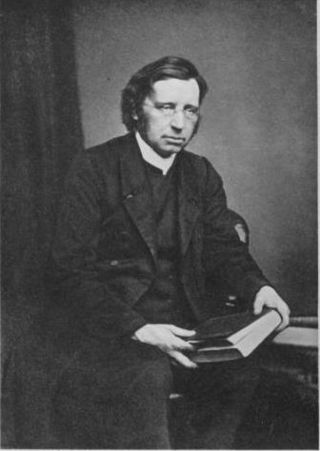
John Mason Neale was an English Anglican priest, scholar, and hymnwriter. He worked and wrote on a wide range of holy Christian texts, including obscure medieval hymns, both Western and Eastern. Among his most famous hymns is the 1853 Good King Wenceslas, set on Boxing Day. An Anglo-Catholic, Neale's works have found positive reception in high-church Anglicanism and Western Rite Orthodoxy.

Carols for Choirs is a collection of choral scores, predominantly of Christmas carols and hymns, first published in 1961 by Oxford University Press. It was edited by Sir David Willcocks and Reginald Jacques, and is a widely used source of carols in the British Anglican tradition and among British choral societies. A second volume was published in 1970, edited by David Willcocks and John Rutter, and the collection is now available in six volumes. A compendium edition was published later. In addition to music for Christmas, the collection also offers works that are suitable for other Christian festivals such as Advent and Epiphany.
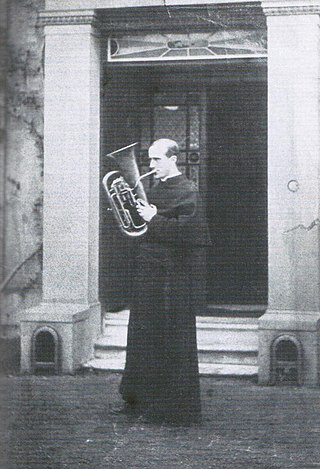
George Ratcliffe Woodward was an English Anglican priest who wrote mostly religious verse, both original and translated from ancient authors. The best-known of these were written to fit traditional melodies, mainly of the Renaissance. He sometimes harmonised these melodies himself, but usually left this to his frequent collaborator, composer Charles Wood.
"Octave" has two senses in Christian liturgical usage. In the first sense, it is the eighth day after a feast, reckoning inclusively, and so always falls on the same day of the week as the feast itself. The word is derived from Latin octava (eighth), with dies (day) understood. In the second sense, the term is applied to the whole period of these eight days, during which certain major feasts came to be observed.

Richard Meux Benson was a priest in the Church of England and founder of the Society of St. John the Evangelist, the first religious order of monks in the Anglican Communion since the Reformation. He is commemorated in the Calendar of Saints of the Anglican Church of Canada on 15 January and on the Episcopal Church calendar on January 14 with Charles Gore.

"O come, O come, Emmanuel" is a Christian hymn for Advent, which is also often published in books of Christmas carols. The text was originally written in Latin. It is a metrical paraphrase of the O Antiphons, a series of plainchant antiphons attached to the Magnificat at Vespers over the final days before Christmas. The hymn has its origins over 1,200 years ago in monastic life in the 8th or 9th century. Seven days before Christmas Eve monasteries would sing the “O antiphons” in anticipation of Christmas Eve when the eighth antiphon, “O Virgo virginum” would be sung before and after Mary's canticle, the Magnificat. The Latin metrical form of the hymn was composed as early as the 12th century.
Events from the year 1853 in the United Kingdom.
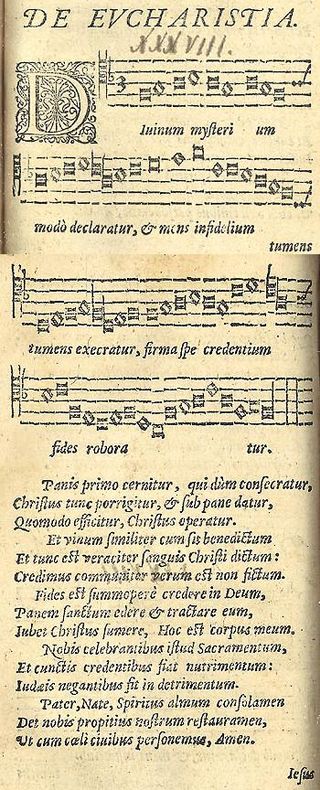
"Of the Father's heart begotten" alternatively known as "Of the Father's love begotten" is a doctrinal hymn based on the Latin poem "Corde natus" by the Roman poet Aurelius Prudentius, from his Liber Cathemerinon beginning "Da puer plectrum" which includes the Latin stanzas listed below.

Thomas Helmore was a choirmaster, writer about singing and author and editor of hymns and carols.
"Past Three O'Clock" is an English Christmas carol, loosely based on the call of the traditional London waits, musicians and watchmen who patrolled during the night, using a musical instrument to show they were on duty and to mark the hours. The refrain dates from at least the early modern period, appearing in print in a 1665 supplement to John Playford's The Dancing Master.
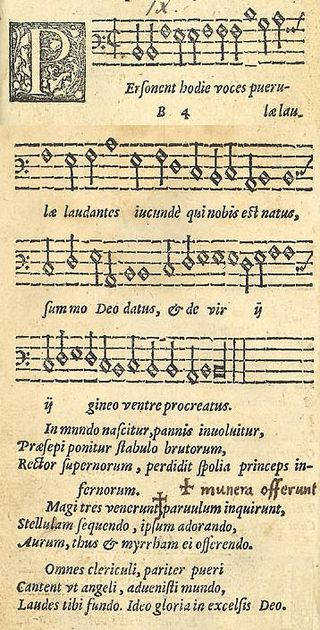
"Personent hodie" is a Christmas carol originally published in the 1582 Finnish song book Piae Cantiones, a volume of 74 Medieval songs with Latin texts collected by Jacobus Finno, a Swedish Lutheran cleric, and published by T.P. Rutha. The song book had its origins in the libraries of cathedral song schools, whose repertory had strong links with medieval Prague, where clerical students from Finland and Sweden had studied for generations. A melody found in a 1360 manuscript from the nearby Bavarian city of Moosburg in Germany is highly similar, and it is from this manuscript that the song is usually dated.

"Puer nobis nascitur", usually translated as "Unto Us Is Born a Son", is a medieval Christmas carol found in a number of manuscript sources—the 14th-century German Moosburg Gradual and a 15th-century Trier manuscript. The Moosburg Gradual itself contained a number of melodies derived from the 12th- and 13th-century organum repertories of Notre Dame de Paris and the Abbey of Saint Martial, Limoges, suggesting that its antiquity may be much greater.

"Es kommt ein Schiff, geladen", is an Advent season chorale and Marian Hymn. It is one of the oldest religious songs of German origin.
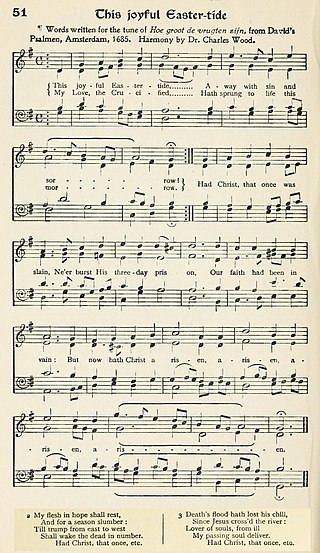
"This joyful Eastertide" is an 1894 Easter carol. The words are by George Ratcliffe Woodward, the tune is from the Netherlands (1624), and the 1894 harmonisation is by Charles Wood.














